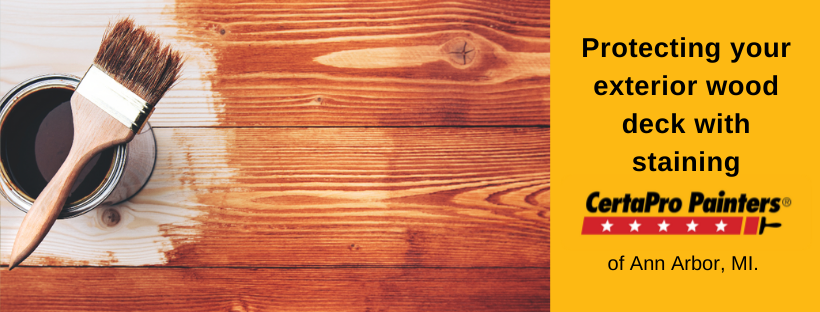
Protecting your exterior wood deck with staining
Posted on August 2, 2021
Often overlooked in discussions of exterior wood staining is the preservative effect it has on the wood itself. With the focus being on appearances it’s worth taking a look at how staining protects what is generally considered to be a major home improvement project – your outdoor deck.
The thinking behind adding a deck to your home is usually to allow for better enjoyment of your outdoor space. Decks are a great way to be outdoors but with a clean level surface under you, that is more conducive to supporting outdoor furniture and gas grills. They might be at lawn level or raised up by a full floor or more above the ground depending both on your home’s architecture and the slope of the lot your house occupies.
For those who haven’t gone with a brick or slate patio the material of choice is wood.
Most decks are built using pressure-treated lumber. Pressure-treating is a process that forces chemicals into the wood to preserve them from rotting and to prevent insects from damaging the wood by using it as a food source. Untreated wood stands little chance of lasting more than a couple of years when it’s fully exposed to the elements but pressure-treated wood can last much longer.
The problem is that pressure-treated lumber isn’t very visually appealing and even with its protective qualities it can’t hold up long enough to make the expense of building a deck seem like a smart investment.
The solution is in applying an oil-based stain.
Once you do decide on building a wooden deck with pressure-treated wood the normal order of construction is to first build it and then let it dry out in the sun for a few weeks (yes weeks!). Most of the lumber will have been very recently pressure-treated and the boards themselves will need time to dry out and contract with prolonged sun exposure.
The way to determine if the wood is ready to be stained is to drip some water on it. If it beads up or isn’t absorbed within a few minutes it’s because the wood is still too wet internally to absorb any more. The ability of the wood to absorb fluids is critical because you are going to want the stain to be absorbed rather than just drying on the surface where it can be scuffed off.
Now that we know when it can be stained let’s look at the why. Beyond simply changing the shade or color of the deck you want to also add another layer of protection to it so that you can get a couple of decades of use from it with just the occasional sanding and restaining to maintain it.
Oil-based stains provide two kinds of protection to your deck. The first is the make it hydrophobic, meaning it will repel water rather than allow it to pass into the wood. This is just a fancy way of saying you want a waterproof deck but keeping the water out is what keeps the preservative chemicals in the pressure-treated wood and prevents rot. It will also greatly reduce the growth of mold and mildew as the oily surface offers a poor place for it to form.
Would painting the deck give the same result? It would for a while but paint works best on vertical surfaces, it does get partially absorbed but it also forms a layer that will crack and chip if you walk on it or move furniture around on it over time.
If you are applying stain to an existing deck that has never been stained or is made from very rough-hewn and finished lumber it’s a good idea to apply two coats of stain to get maximum absorption.
The second benefit you get is UV protection. The sun will turn unfinished wood planks into unsightly gray planks if left fully exposed. With a UV protectant added to most modern stains the finish you get from day one will continue to hold up over a number of years before needing to be restained.
When you’re planning on having a new deck stained or an existing deck restained let the pros at CertaPro of Ann Arbor do it for you and provide expert results using the best quality stains on the market. Schedule a free estimate today!





